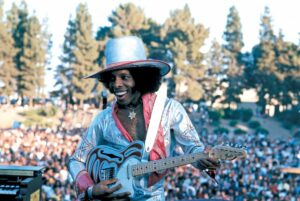(June 9, 2025) One of the most important, influential, enigmatic musical stars of our lifetimes has passed. Today, we say goodbye to the great Sly Stone. He was 82.
In the transition from the soul music of the 1960s to the R&B funk band era of the 1970s, all roads passed through Sly Stone and his groundbreaking group, Sly & The Family Stone. A visionary musician, composer and bandleader whose work transformed music in ways that still reverberate, Sly Stone created a style of music that blended elements of rock, pop, traditional R&B and the funk foundation built by James Brown into a new, universal music style the appeal of which crossed age, gender, racial and socioeconomic boundaries, and set the stage for future acts ranging from Earth Wind & Fire to George Clinton & P-Funk, and even to the later emergence of hip-hop. He was that important.
Stone was born on March 15, 1943 in Denton, Texas as Sylvester Stewart, but moved to Bay Area of California with his family as a child. By the time he was a teen, Stewart, nicknamed “Sly,” was a multi-instrumentalist playing in several bands. After high school, he began producing a number of local bands for the Autumn Records label, scoring a top 10 hit with Bobby Freeman’s “C’mon and Swim” in 1964.
Sly & The Family Stone was born in 1967, as the merger of two local bands, and soon had put together its most famous lineup of brothers Sly Stone and singer/guitarist Freddie Stone, their sister singer/keyboardist Rose Stone, trumpeter Cynthia Robinson, drummer Gregg Errico, saxophonist Jerry Martini, bassist Larry Graham.
Signed to Epic Records, the band took awhile to connect with audiences – fortunately at a time when record companies were more patient – finally hitting in 1969 with “Everyday People,” which went all the way to #1 and set up the band’s 1969 Woodstock performance. Coming out of their transcendent performance at Woodstock, Sly & the Family Stone lit up the charts through the mid 1970s with such iconic hits as “Thank You (Falletinme Be Mice Elf Again),” “Dance To the Music,” “Stand!,” “I Want To Take You Higher,” and “Hot Fun In the Summertime.” Their albums were events – all wheat, no chaff.
Ultimately, the highs and lows of it all took their toll and the group disbanded in 1975, going their separate ways. Stone’s solo career was spotty, and he eventually became somewhat of a recluse, disappearing at times for years. Dozens of times he was falsely rumored to be returning to the forefront, and other times he would appear unexpectedly. Drug use took its toll on him, and he became the subject of wild rumors ranging from homelessness to lavish lifestyle.
Stone was recognized by subsequent generations of stars as a transcendent influence on popular music, and his 60s and 70s work was generously was covered and sampled. But even as his gravitas grew, Stone receded further and further from the spotlight.
By the time he hit his 70s, it was clear that Stone had effectively retired and was living a quiet life as he chose, even as others in the Family Stone occasionally reunited for shows. Though he remained silent, his influence grew unabated. And as we look back at Sly Stone today, it will not be those years of silence that we will think of. Instead, the world will focus on the almost unparalleled musical genius of a transformational artist whose light continues to shine more than a half century after his commercial and critical peak. Rest in peace.
By Chris Rizik










